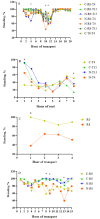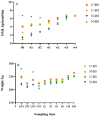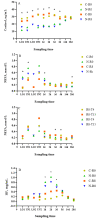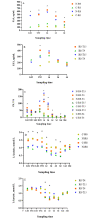Effect of rest, post-rest transport duration, and conditioning on performance, behavioural, and physiological welfare indicators of beef calves
- PMID: 36454988
- PMCID: PMC9714911
- DOI: 10.1371/journal.pone.0278768
Effect of rest, post-rest transport duration, and conditioning on performance, behavioural, and physiological welfare indicators of beef calves
Abstract
The aim of this study was to assess the effects of conditioning, rest, and post-rest transport duration on welfare indicators of 6-7 mo old beef calves following a 20-h transport. Three hundred and twenty-eight weaned calves (237 ± 29.7 kg of BW) were randomly assigned to a 2 × 2 × 2 nested factorial design: conditioning, conditioned (C) or non-conditioned (N); rest, 0 (R0) or 8 (R8) h, and post-rest transport, 4 (T4) or 15 (T15) h. Calves were sampled before (LO1) and after (UN1) the initial 20-h journey, before (LO2) and after (UN2) the additional 4 or 15-h journey, and at 1, 2, 3, 5, 14, and 28 d after UN2. Data was analyzed using the GLIMMIX procedure of SAS. Fixed effects included conditioning, transport, and time nested within rest period, while random effects included animal and pen. Greater shrink (p < 0.01) was observed in C than N calves after the initial 20-h transport. During the first week after transportation, the mean ADG of N calves was greater than C calves (p < 0.01). From d 14 to d 28, however, the mean ADG of C calves was greater than N calves (p < 0.01). Flight speed, cortisol and L-lactate concentrations were greater (p ≤ 0.05) in C than N calves between LO1 and d 5, while greater (p ≤ 0.02) non-esterified fatty acids, creatine kinase, serum amyloid-A, and haptoglobin concentrations were observed in N than C calves between LO1 and d 3. The R8-T4 calves had greater (p < 0.01) ADG than R8-T15 calves between LO1 and d 5. The R0-T4 calves had greater L-lactate concentrations than R0-T15 and R8-T4 calves (both p = 0.02) on d 1. The R0 calves had greater (p < 0.01) ADG than R8 calves between 14 and 28 d. This study suggests that C calves are better fit for transport than N calves as evidenced by behavioural and physiological parameters. Fewer and inconsistent differences were observed for rest and post-rest transport treatments.
Copyright: © 2022 Meléndez et al. This is an open access article distributed under the terms of the Creative Commons Attribution License, which permits unrestricted use, distribution, and reproduction in any medium, provided the original author and source are credited.
Conflict of interest statement
The authors have declared that no competing interests exist.
Figures






Similar articles
-
Effect of transport and rest stop duration on the welfare of conditioned cattle transported by road.PLoS One. 2020 Mar 2;15(3):e0228492. doi: 10.1371/journal.pone.0228492. eCollection 2020. PLoS One. 2020. PMID: 32120382 Free PMC article.
-
Effects of conditioning, source, and rest on indicators of stress in beef cattle transported by road.PLoS One. 2021 Jan 12;16(1):e0244854. doi: 10.1371/journal.pone.0244854. eCollection 2021. PLoS One. 2021. PMID: 33434915 Free PMC article.
-
Effect of rest stop duration during long-distance transport on welfare indicators in recently weaned beef calves.J Anim Sci. 2017 Feb;95(2):636-644. doi: 10.2527/jas.2016.0739. J Anim Sci. 2017. PMID: 28380612 Clinical Trial.
-
A randomized controlled trial evaluating the effect of providing a rest period during long-distance transportation of surplus dairy calves: Part II. Effect on hematological variables.J Dairy Sci. 2024 Nov;107(11):9774-9785. doi: 10.3168/jds.2024-25012. Epub 2024 Jul 14. J Dairy Sci. 2024. PMID: 39004132
-
Current Knowledge on the Transportation by Road of Cattle, including Unweaned Calves.Animals (Basel). 2023 Nov 1;13(21):3393. doi: 10.3390/ani13213393. Animals (Basel). 2023. PMID: 37958148 Free PMC article. Review.
References
-
- Blokhuis H, Jones R, Geers R, Miele M, Veissier I. Measuring and monitoring animal welfare: transparency in the food product quality chain. ANIMAL WELFARE-POTTERS BAR THEN WHEATHAMPSTEAD-2003; 12(4):445–456.
-
- Canadian Department of Justice. Health of Animals Regulations SOR/91-525, s.2. 2010. https://lawslois.justice.gc.ca/eng/regulations/C.R.C.,_c._296/20100422/P... (accessed January 5, 2022).
Publication types
MeSH terms
Substances
LinkOut - more resources
Full Text Sources

